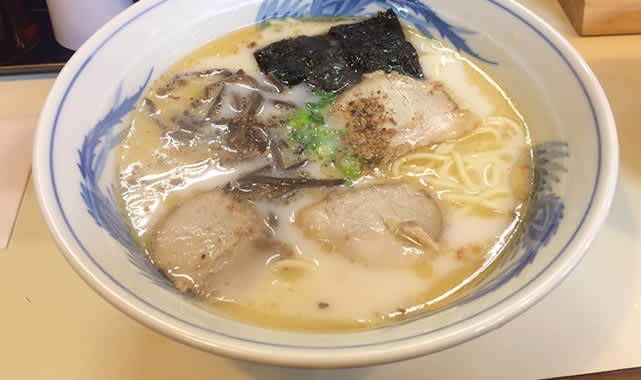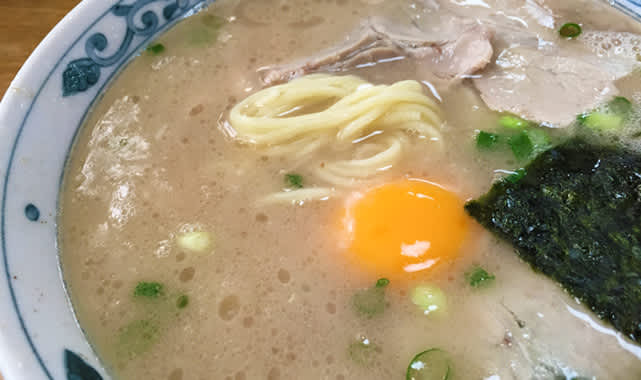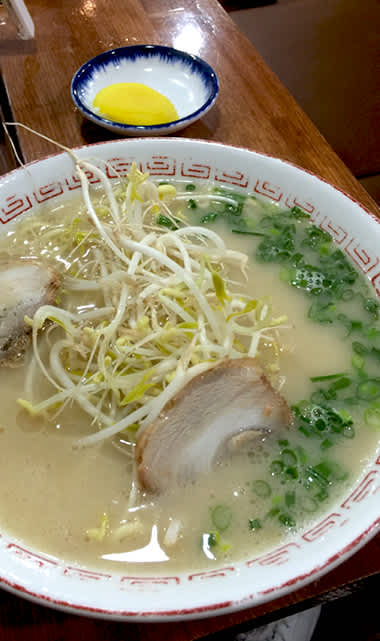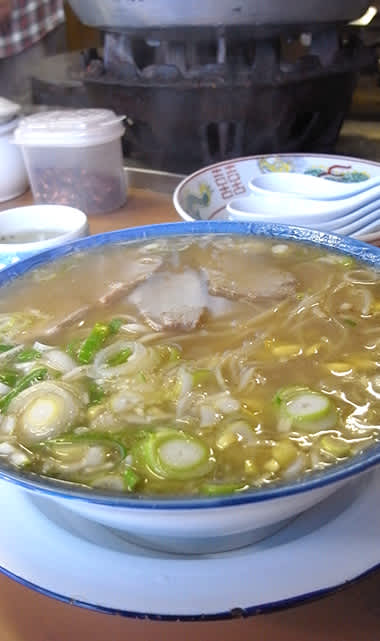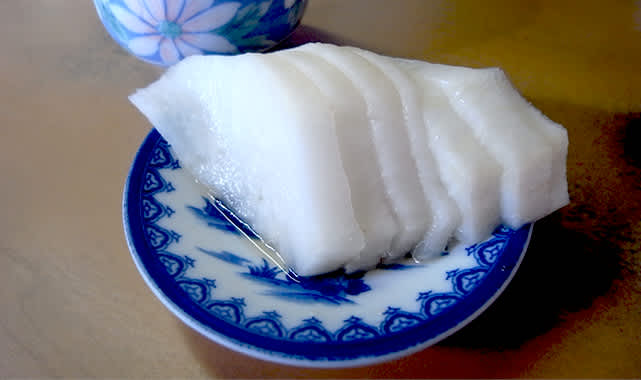
Story RAMEN By JNTO on 25 August 2020
Tonkotsu ramen, which is taking the world by storm,
was born in Kyushu
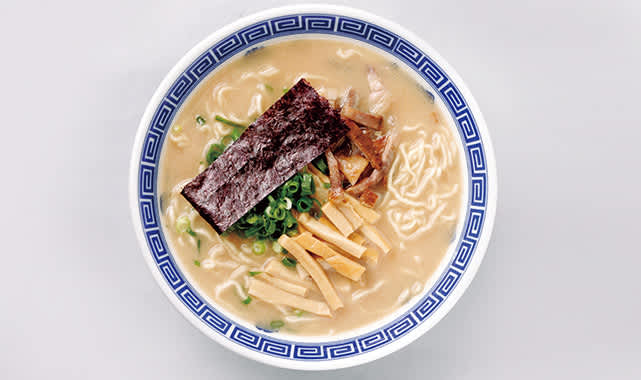
Recently, Japanese ramen has been gaining popularity all around the world, almost reaching the level of popularity earned by sushi. Ramen has a wide variety of soups, noodles, and ingredients, including tonkotsu (pork bone) soup, shoyu (soy sauce) soup, miso soup, and original noodles. There are numerous kinds of local ramen all over Japan. Among others, tonkotsu ramen has been gaining fans around the world, as a “hot” Japanese dish. Kyushu is the birthplace of tonkotsu ramen and the “holy ground of tonkotsu,” with its deeply-rooted tonkotsu ramen culture. This article will start with introducing the history of the origin and spread of Kyushu Ramen.
Tonkotsu ramen was born in 1937, making it 80 years old in 2017
Kyushu Ramen is a collective term for local noodles in Kyushu, including Hakata Ramen and Kumamoto Ramen. Although thickness of the noodles and ingredients may vary, the soup, which is the base of the dish, is uniformly white, cloudy tonkotsu soup. When talking about Kyushu Ramen, one must mention Kurume City (Fukuoka Prefecture) which is said to be the birthplace of tonkotsu ramen.
Tonkotsu ramen was first created at Nankinsenryo, a street-side vendor selling ramen on Meiji-dori Street in Kurume City in 1937. The first owner, who used to run an udon noodles shop, created tonkotsu ramen based on the combination of “shina-soba” (shoyu ramen), which was popular at the time in Tokyo and Yokohama, and “champon” noodles, which is the local specialty of his own hometown, Nagasaki. At that time, although Chinese restaurants offered noodles in soup, the soup was made from chicken bones. It is said that the owner decided to use pork bone, as it was cheaper than chicken bones.
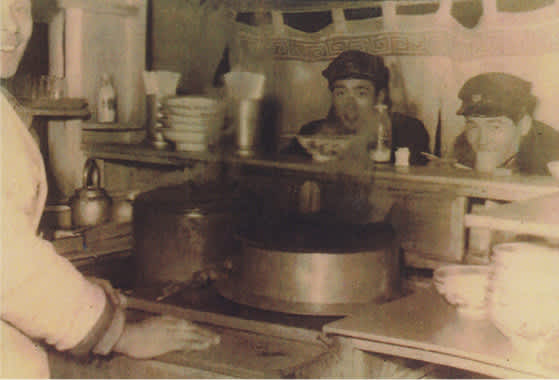
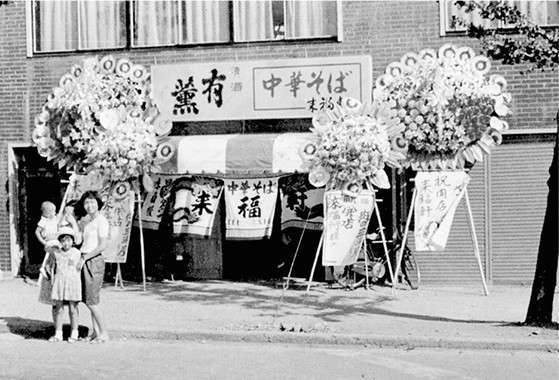
However, the first ramen noodles created at Nankinsenryo were different from the typical tonkotsu ramen we see nowadays. The soup used to be somewhat clear.
So, how and when was the white, cloudy soup born? It was at Sankyu in Kurume City, which started up in 1947, 10 years after Nankinsenryo created the tonkotsu ramen.
One day, when the owner went out, tonkotsu soup was simmering on the stove. The soup got so boiled that it became white and cloudy. He seasoned it, tried it, and found it was very delicious. In this way, white, cloudy tonkotsu soup was born by accident.
From Kurume to all over Kyushu
Sankyu, who created the white, cloudy tonkotsu soup, later opened branches in Saga City (Saga Prefecture) and Tamana City (Kumamoto Prefecture). The founders of famous ramen shops, including Keika, Komurasaki, Ajisen Ramen, and Shoyoken, visited the Tamana branch of Sankyu to learn the taste of the new tonkotsu soup and later opened their own shops of tonkotsu ramen in Kumamoto City, creating a new type, Kumamoto Ramen, which is characterized by deep-fried garlic chips. In addition, Miyazaki Ramen also traces its origin to Kurume.
As described above, tonkotsu ramen, which was born in Kurume, spread all over Kyushu in a radial fashion and developed as original ramen in each area. Another contributor to the prevalence of tonkotsu ramen is long-distance truck drivers. They spread the reputation of tonkotsu ramen all over Japan. Recently, ramen shops from Fukuoka extended their business not only to other areas across the country but also all over the world, further enhancing its popularity.
Nankinsenryo in Kurume City (Fukuoka Prefecture), the birthplace of Kyushu Ramen, is still in business and is now celebrating its 80th anniversary in 2017. In this milestone year, enjoy tonkotsu ramen while recalling to mind the story behind the acclaimed dish.
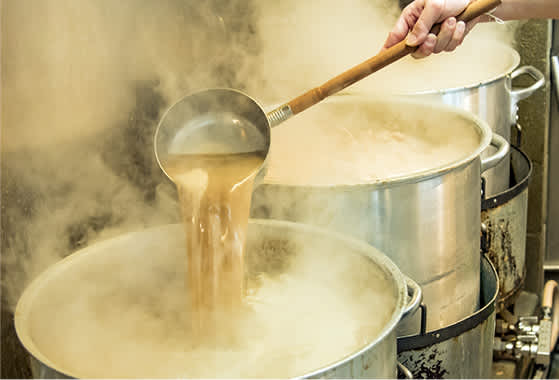
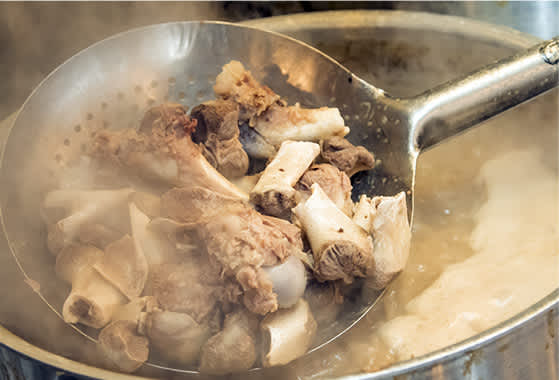
What is Hakata ramen?
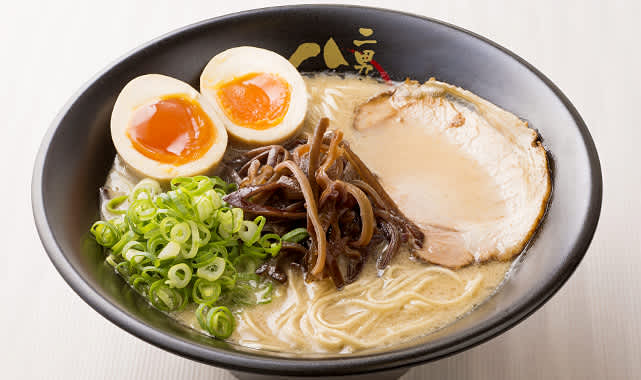
Types of ramen include "tonkotsu," "miso," "shoyu (soy sauce)," "shio (salt)," and other original soups, with various features from various regions, further dividing each type of ramen into many sub-types. Japan has a large variety of ramen. Kyushu is known as the kingdom of tonkotsu ramen and Hakata ramen in Fukuoka Prefecture is the most famous sub-type of tonkotsu ramen.
Thin noodles, originated from ramen stands
Soy sauce flavored rich tonkotsu soup
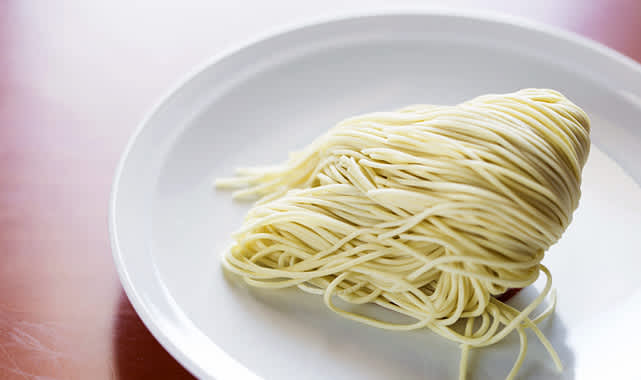
Hakata ramen, which is mainly characterized by its thin noodles, has a unique "kaedama" refill system, which allows the refill of noodles only. This system was born at ramen stands in the Nagahama area, which is adjacent to a fish market. It is said that in order to serve ramen quickly to workers at the fish market, thin noodles were invented, and the kaedama system was developed to satisfy the large appetites of these physical laborers.
It should also be noted that you can choose the firmness of the noodles. The choices include "yawa (soft)," "futsu (normal)," "kata (hard)" and "barikata (extra hard)," as well as special terms only used by hard-core local ramen fans, such as "harigane" and "konaotoshi," both indicating hard noodles. In the kaedama system, you cannot get a refill of soup, so it is important to watch how much soup you consume in the first bowl.
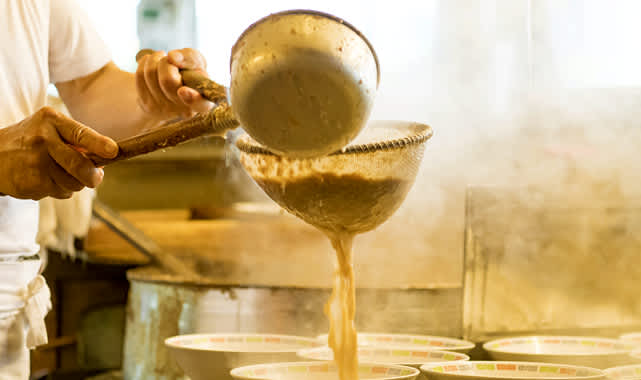
White cloudy tonkotsu soup is the mainstream for Hakata ramen. Each ramen shop has its own way of making tonkotsu soup, with various choices for which parts of pork should be used, including head, backbones, and legs, how to treat pork bones, how long the soup should be simmered, how much lard should be added, and how to deal with the pork-specific flavor, either to enhance it or remove it, creating unique ramen soup. Tools, such as strainers to drain noodles and pots to simmer the soup, are also important for making tonkotsu soup, and you may notice that some differences of the tools may contribute to the differences among the soups.
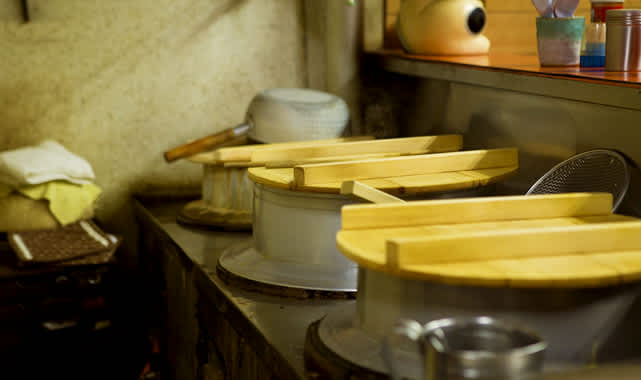
The main toppings of Hakata ramen are "takana (pickled takana leaves)" and "beni-shoga (pickled ginger)." You can add them to the ramen to vary the taste. Many shops offer them, which are already set on the table, for free. Make sure to enjoy the soup as it is first, and then you can add a small amount of the toppings as you eat the ramen.
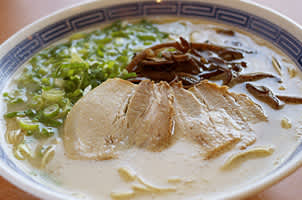
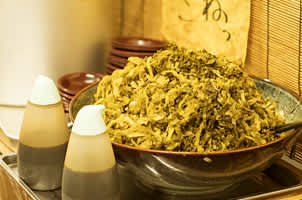
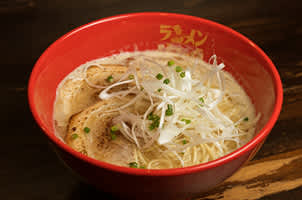
“Hakata Ikkousha,” the undisputed world leader of Hakata ramen
Enjoy authentic Hakata tonkotsu ramen with “shiho” (fatty bubbles)
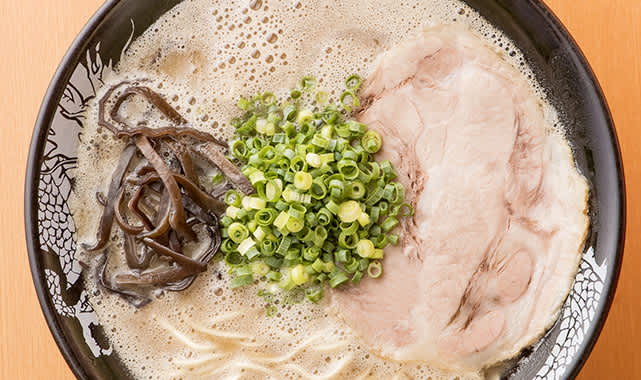
First, take a look at the tonkotsu ramen in this photo.
The big slices of pork, “char siu,” are indeed impressive, but can you also see all the bubbles floating on the surface of the soup? They are “shiho” (fatty bubbles), naturally formed when the soup is stirred while simmering to incorporate air into the soup. These bubbles indicate that an experienced chef has used a lot of pork bones to enhance and concentrate the “umami.” This excellent ramen with such bubbles is served at “Hakata Ikkousha” in Fukuoka. You may have to join the queue of people outside but the wait is worth it to partake of their “Ganso Awa-kei (authentic tonkotsu soup with fatty bubbles) ramen.”
Hakata Ikkousha opened in Daimyo, Fukuoka City in 2004. It currently has 14 shops in Japan and 36 shops in other countries. Kosuke Yoshimura, the founder, has been eating Hakata ramen since he was little, and is now running this ramen shop with a belief in the potential of Hakata ramen. He invented an original “Hakata tonkotsu” soup that enhances the flavor of pork bones.
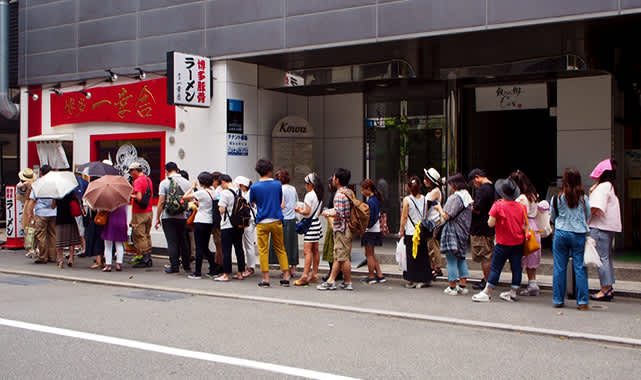
Located 5 minutes away on foot from JR Hakata Station, “Hakata Ikkousha - Hakata Main Store” is easily accessible and attracts many foreign tourists and visitors from all over Japan, as well as local people. Its ramen is worth trying even after waiting in a long queue.
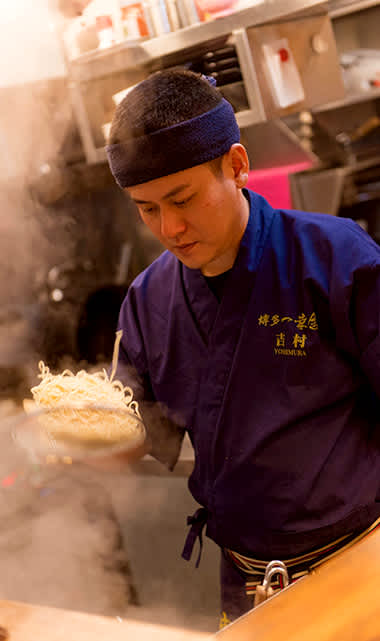
Kosuke Yoshimura, the founder of Hakata Ikkousha, is very serious about making ramen.
He confidently claims that he is more enthusiastic about making ramen than anyone else in the business.
An iron “hagama” pot is best used for simmering because of its great heat conductivity. Pork bones from various parts of the pig, including head and back, from which blood has been drained completely, are boiled on high heat until they fall apart. Two kinds of soup, one simmered for a long time and the other simmered for a shorter time, are mixed to condense the umami and create a creamy tonkotsu soup.
Following the concept that “a real ramen shop must make its own noodles,” he uses only home-made noodles. The traditional style of flat, thin noodles enhances the aroma of the wheat. The noodles are cooked and quickly drained.

One essential part of ramen is the soy sauce-based mixture added to the soup. Every ramen shop has its own secret recipe for this mixture. Hakata Ikkousha uses three kinds of soy sauce that are produced in Fukuoka Prefecture mixed with a dashi soup made with five ingredients. The char siu is added to the mixture to add the umami from meat. This mixture gives depth and richness to the tonkotsu soup.
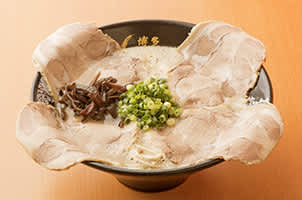
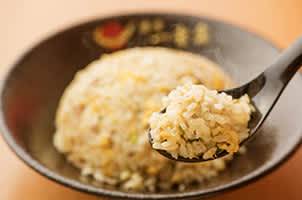
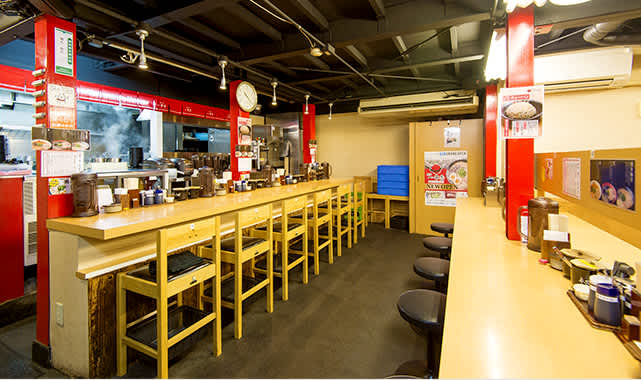
Hakata Ikkousha - Hakata Main Store
- Address:
- Kowa Building 1F, 3-23-12 Hakata Ekimae, Hakata-ku, Fukuoka City, Fukuoka Pref.
- Phone:
- 092-432-1190
- Business hours:
- 11:00 - 24:00, Sundays 11:00 - 21:00
- Closed:
- Open everyday
- Access:
- About 5 minutes on foot from JR Hakata Station (Hakata Exit)
- Website:
- https://www.ikkousha.com/english
-
Other varieties of Kyushu Ramen
- Hakata ramen is not the only Kyushu ramen!
Let’s try some of the other great local ramens. -
Articles about the origin and history of Kyushu tonkotsu ramen have been taken up previously, with a particular focus on Hakata ramen being its main representative. Let us now introduce the charms and uniqueness of other varieties of Kyushu ramen. Many places in Kyushu have their own “local ramen”, and the main feature of these are the distinctive cloudy broths made from pork bone. After the first Kyushu tonkotsu based ramen was created in Kurume in 1937 the idea began to spread to all over Japan and was redeveloped locally. The following are some of the major Kyushu tonkotsu ramen types aside from the Hakata variant.
Kumamoto Ramen
Komurasaki ramen The father of cloudy pork bone broth, Kurume Sankyu ramen, established in 1947, opened a branch shop in Tamana City in the northwest part of Kumamoto Prefecture. Some founders of now-well-known ramen shops such as Keika, Komurasaki, Ajisen Ramen and Shoyoken learned the recipe at this shop and were pioneers who spread tonkotsu ramen to Kumamoto City. One feature of Kumamoto ramen is garlic chips. Garlic chips were brought by the founder of Ajisen Ramen from his own country, Taiwan. Garlic is well used in Kumamoto ramen, which originated with these fried garlic chips and developed into various recipes using such ingredients as roasted garlic and “ma-yu” lard-fried garlic.
Saga Ramen
Koyo-kaku ramen
Kurume Sankyu also established a branch shop in Saga City just as in Tamana City, creating the base of Saga ramen. Such features of Kurume ramen as nori seaweed-sheet topping can still be found in many long established ramen shops in Saga. Another characteristic way to enjoy Saga ramen is by mixing egg yolk into the soup. - Miyazaki Ramen
-
Horai ramen - Miyazaki ramen is also said to be originated from Kurume ramen. It features a mild and gentle pork bone soup and straight noodles with medium thickness. The founder of Kimura, established in 1953, learned about ramen at Kurume Sankyu in its early days. While many Hakata ramens are served with takana pickles, in Kagoshima and Miyazaki prefectures, daikon (Japanese radish) pickles are served instead. In particular, “takuan” radish pickles are often served in Miyazaki, because Tano in Miyazaki City has a lot of pickle factories and is a famous place for daikon production.
- Kagoshima Ramen
-
Noboru-ya ramen -
Kagoshima ramen is the only ramen in Kyushu that is not influenced by Kurume’s cloudy pork bone broth. Its broth is made from chicken stock together with pork bone, creating a plain flavor, and noodles are mainly thick. It is quite unique that ramen is served together with a dish of “senmai-zuke” pickled radish at many ramen shops there.
Noboru-ya is the oldest ramen shop in Kagoshima, established in 1947. The founder of this shop, a woman, was a nurse who worked in Yokohama and who learned the recipe from a Chinese person. Noboru-ya had been closed for some time, but it re-opened in 2016.
Kagoshima ramen style is to eat pickled daikon while waiting for your ramen. As you can now see, tonkotsu ramen has regional variations. By focusing on the difference in thickness of noodles and what is served with ramen, you will enjoy tonkotsu ramen even more.

























































